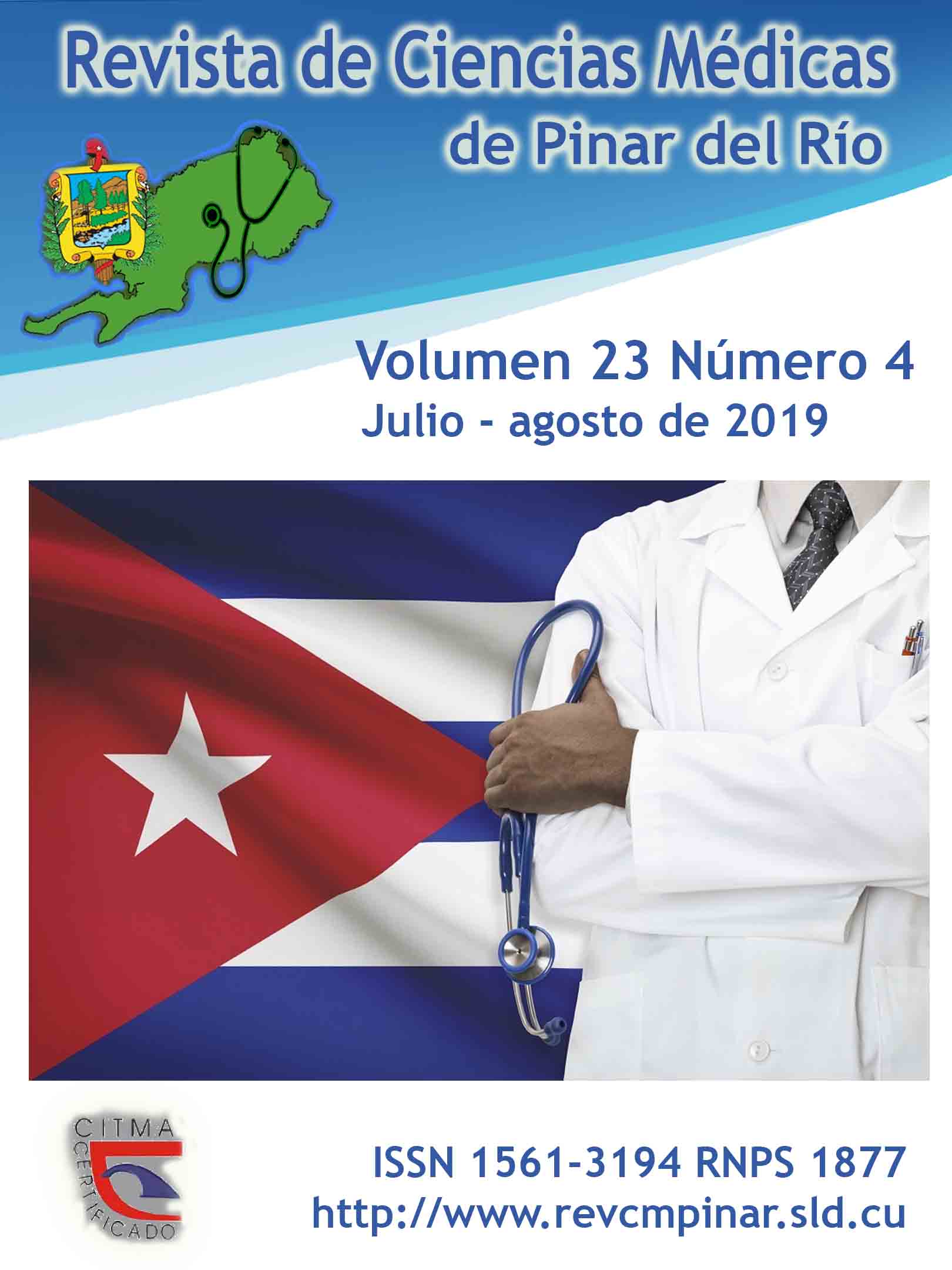Eosinophilic colitis
Keywords:
PEDIATRICS, COLITIS, INTESTINAL IBSTRUCTION, EOSINOPHILIA, DIARRHEA.Abstract
Introduction: eosinophilic colitis is a gastrointestinal disorder characterized by an inflammatory infiltration in the colon and rectum, with predominance of eosinophils, its clinical manifestation depends on the affected intestinal epithelium layer, the exclusive affectation of the colon is exceptional, intestinal obstruction is the most evident manifestation and it is a disease of complex diagnosis, where the histological study is conclusive. It is present from 1 to 20 inhabitants per 100.000, its etiology is imprecise, it has been determined that there is an important genetic and allergic component. Corticosteroids are the treatment of first choice.
Case report: a 12-year-old patient, presented abdominal pain, distension and was admitted, evolved with clinical and radiological signs of a mechanical ileus with progressive worsening, it was decided an exploratory laparotomy and colon biopsy. The patient was diagnosed with eosinophilic colitis and treated with corticosteroids, showing a satisfactory progression at 72 hours, with regression of the clinical chart.
Conclusion: it is rare and little study pathology, not frequently found, it affects the muscular layer as a type of intestinal obstruction, this should be taken into account as a differential diagnosis of acute abdomen in pediatric patients.
Downloads
References
1.- Blasco Alonso J, Serrano Nieto J, Girón Fernández Crehuet F, Carazo Gallego B, Navas López VM. Colitis eosinofílica en pacientes pediátricos intervenidos de enfermedad de Hirschsprung. Rev Pediatr Aten Primaria [Internet]. 2017 [citado 28/06/2018]; 19(76): [aprox. 4p.]. Disponible en: https://pap.es/articulo/12597/?id=12597&titulo
2.- Muñoz Guzmán M, Hernández Suyo A, Deriaz Alvarez J, Rodríguez Hurtado D. Eosinophilic gastroenteritis: A case report and a review of theliterature. Rev. gastroenterol. Perú [Internet]. 2017 Abr [citado 28/06/2018]; 37(2): [aprox. 4p.]. Disponible en: http://www.scielo.org.pe/scielo.php?script=sci_arttext&pid=S1022-51292017000200013&lng=es.
3.- Medina Navarro DA, Martínez Pérez M, Toro Monjaraz E M, López Pérez G. Colitis eosinofílica y comorbilidad alérgica. Presentación de un paciente en edad escolar. Revista asma y alergia [Internet]. 2016 [citado 20/09/2018]; 25(3): [aprox. 1p.]. Disponible en: http://www.medigraphic.com/pdfs/alergia/al-2016/al163d.pdf.
4.- Coste Murillo P, Sauma Rodríguez J. Colitis eosinofílica: presentación endoscópica inusual. Endoscopia [Internet]. 2016 Oct- Dic [citado 28/06/2018]; 28(4): [aprox. 7p.]. Disponible en: https://www.elsevier.es/es-revista-endoscopia-335-articulo-colitis-eosinofilica-presentacion-endoscopica-inusual-S0188989316300690
5.- Ríos Touma CM, Calahorrano Acosta J, Banderas Poveda P. Colitis eosinofílica: diagnóstico y tratamiento. A propósito de un caso [Internet]. Ecuador: Universidad San Francisco de Quito; 2018 Sep. [citado 27/12/ 2018]. Disponible en: http://repositorio.usfq.edu.ec/bitstream/23000/5902/1/126477.pdf#page=74.
6.- Rodríguez Álvarez J, Zárate Mondragón F, Cervantes Bustamante R, Ramírez Mayans J. Gastroenteropatía eosinofílica: reporte de 12 casos en población pediátrica; descripción histopatológica y asociación clínica en un Centro Hospitalario de la Ciudad de México. Alerg Asma Inmunol Pediatr [Internet]. 2017 [citado 27/12/2018]; 26(3): [aprox. 5p.]. Disponible en: https://www.medigraphic.com/pdfs/alergia/al-2017/al173e.pdf
7.- Garibay Vargas OM, Soto Candía D, Ramírez EC, Castrejón Vázquez MI, Vargas Camaño ME, Ramos Acosta G, et al. Gastroenteritis eosinofílica. Caso clínico. Revista Alergia México [Internet]. 2014 [citado 28/09/2018]; 61(3): [aprox. 6p.]. Disponible en: revistaalergia.mx/ojs/index.php/ram/article/download/44/58
8.- Ostiz M, Zelaya MV, Laiglesia M, Campillo A, Kutz M, León Brito M. Colitis eosinofílica primaria en paciente con enfermedad celíaca. An. Sist Sanit Navar [Internet]. 2018 [citado 12/01/2019]; 41(2): [aprox. 3p.]. Disponible en: https://recyt.fecyt.es/index.php/ASSN/article/view/64296/40718
9.- Bonilla GR, Pérez GG. Gastroenteropatía eosinofílica. Reporte de un caso y revisión de la literatura. Rev Col Gastroenterol [Internet] 2014 Oct-Dic [citado 28/09/2018]; 29(4): [aprox. 5p.]. Disponible en: http://www.scielo.org.co/scielo.php?pid=S0120-99572014000400011&script=sci_abstract&tlng=es
10.- Grinblat V. Patologías digestivas eosinofílicas. 3° Jornadas Nacionales Conjuntas de Alergia e Inmunología en Pediatría. Del 21 al 26 Abril de 2016. Clínica Universitaria Reina Fabiola: Sociedad Argentina de Pediatría. Disponible en: http://www.sap.org.ar/docs/Congresos2016/2016%20Aergia%20e%20Inmunolog%C3%ADa/patologias_digestivas_eosinofilas.pdf.
11. - Mogilevski T, Nickless D, Hume S. β-lactam-associatedeosinophilic colitis. BMJ Case Rep [Internet]. 2015 Jun [citado 12/01/2019]; 2015. Disponible en: https://www.ncbi.nlm.nih.gov/pubmed/26106168.
12.- Uribarren Berrueta T. Strongyloidosis. [Internet] México: Universidad Nacional Autónoma de México; 2017 Nov [citado 12/01/2019]. Disponible en:
http://www.facmed.unam.mx/deptos/microbiologia/parasitologia/strongyloidosis.html.
13.- Guerrero Doria K, Escobedo Chávez MP, Sevilla Bacilio J, Moncada Barrón D, Flores Nava G. Síndrome disentérico, insuficiencia cardiaca y anemia grave por tricuriasis. Presentación de un caso y revisión bibliográfica. Acta Pediatr Mex [Internet]. 2018 Mar [citado 12/01/2019]; 39(2): [aprox. 4p.]. Disponible en: https://www.medigraphic.com/pdfs/actpedmex/apm-2018/apm182g.pdf
14.- Cerutti L. Síndrome hipereosinofílico. Archivos de alergia e inmunología clínica [Internet]. 2018 [citado 12/01/2019]; 49(1): [aprox. 24p.]. Disponible en: http://www.archivos.org.ar/contenido/lst.art.sec.php?recordID=TW9ub2dyYWbDrWE=.
15.- Hu Liang H, Leitón Chaves A, Salas Mena C. Sindrome de Churg Strauss: a propósito de dos casos en el Hospital San Vicente de Paú. Hospital San Juan de Dios, San José, Costa Rica. Fundado en 1845. Rev Cl EMed UCR [Internet]. 2016 Oct [citado 12/01/2019]; 6(IV): [aprox. 10p.]. Disponible en: https://revistas.ucr.ac.cr/index.php/clinica/article/view/26921
Published
How to Cite
Issue
Section
License
Authors who have publications with this journal agree to the following terms: Authors will retain their copyrights and grant the journal the right of first publication of their work, which will be publication of their work, which will be simultaneously subject to the Creative Commons Attribution License (CC-BY-NC 4.0) that allows third parties to share the work as long as its author and first publication in this journal are indicated.
Authors may adopt other non-exclusive license agreements for distribution of the published version of the work (e.g.: deposit it in an institutional telematic archive or publish it in a volume). Likewise, and according to the recommendations of the Medical Sciences Editorial (ECIMED), authors must declare in each article their contribution according to the CRediT taxonomy (contributor roles). This taxonomy includes 14 roles, which can be used to represent the tasks typically performed by contributors in scientific academic production. It should be consulted in monograph) whenever initial publication in this journal is indicated. Authors are allowed and encouraged to disseminate their work through the Internet (e.g., in institutional telematic archives or on their web page) before and during the submission process, which may produce interesting exchanges and increase citations of the published work. (See The effect of open access). https://casrai.org/credit/



